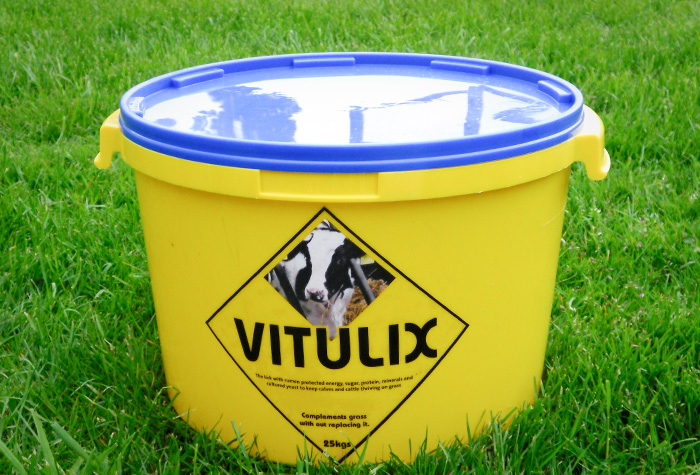An energy lick containing 25% more energy and minerals than calf concentrates is enabling grass-reared heifers to achieve a 24-month calving age target.
Vitulix, a lick specifically designed for young calves at grass, is introduced to replacement heifers at three-to-four months of age on Philip and Conor Beausang’s farm in Co. Waterford.
The lick is first introduced to calves when they are turned out to grass and taken off concentrate feed.
Efficiency is at the heart of the Beausang’s spring-calving dairy system in Grange, Co. Waterford. The family’s farm is a Teagasc ‘monitor farm’ and is home to a herd of 120 Holstein Friesian cows.
The Beausangs switched to dairying from suckler production in 2011 when they installed a second-hand, eight-unit milking parlour. They later went on to add another four units.
Maintaining mineral levels at the correct amounts is an important consideration in the Beausang’s approach to rearing replacement heifers. Calves are weighed at regular intervals to monitor weights to meet breeding targets.
Not only does Vitulix provide Philip and Conor’s calves with their mineral requirements, but it also contains 25% more energy than calf ration.
Taken on a ‘little and often’ basis, it complements grass intake and rumen development.
Co. Cork farmer a firm believer in Vitulix
Another dairy farmer, Michael Flavin, has also witnessed the benefits of Vitulix first hand. The energy lick, costing as little as 15c/day, gives heifers on his Co. Cork dairy farm 24-hour access to protected nutrients.
Flavin runs a spring-calving herd of 85 Friesian cows on the outskirts of Youghal. His herd produces an average annual milk yield of 7,000L/cow.
At three-to-four months calves are introduced to Vitulix. Michael offers it to them before he withdraws meal.
He calculates that feeding Vitulix costs him around 13c/head/day and he is making savings on meal during the grazing season.
“Using Vitulix is less hassle than meal. It means I don’t have to carry meal to the field every day,” he said.
An added benefit is that birds don’t forage on the lick, unlike meal.
“I am not paying to feed the birds as I would be if I fed meal in a feed trough,” he added.
This may also reduce potential cases of coccidiosis, as birds are known carriers of this contagious, scour-causing disease.
Michael has noticed that his calves are more satisfied and content on Vitulix because they can come and go as they please.
He places buckets close to a water trough to enhance intakes. Approximately 80 of his calves consume two 25kg buckets every 10 days. This equates to 62.5g/head/day.
Helping smaller calves keep up with the rest of the group
Dr. Amanda Dunn of Uniblock, which manufactures Vitulix, said smaller calves can consume what they need and this helps them to keep up with the rest of the group.
“Smaller calves get less meal at the trough compared to the older and bigger calves, but with Vitulix they can consume what they need,’’ she said.
Vitulix is made with evaporated molasses so each block is over 95% dry matter. To achieve this, 800kg of fresh molasses is added to 400kg of dry ingredients to produce 1t of product.
It is balanced with protected minerals, fat and proteins to ensure maximum dry matter intakes and protection.
Will Quinn of Jim Quinn Farm Supplies, who introduced both farms to Vitulix, said the top layer of the product can be licked whilst the new, exposed layer needs time to soften.
This means that, while the product is highly palatable, intakes are controlled.
“Vitulix is also ideal for feeding with good silage to weanlings,’’ he said.
“Just like there are calves that drink milk fast, there are calves that eat ration fast and by putting calves of different ages together it will exaggerate the problem.
“But with Vitulix, the calves can only lick so much at a time and it can, therefore, be digested more efficiently,” he added. Click here for more information




